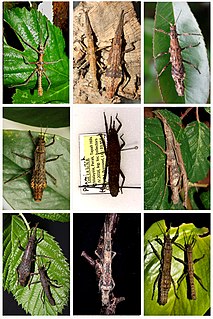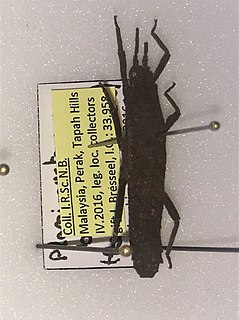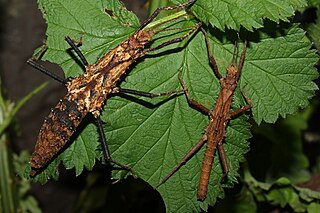
The Heteropterygidae is a family of stick insects belonging to the suborder Euphasmatodea. Species can be found in Australasia, East and Southeast Asia. More than 130 valid species are descriebed.

The Obriminae are the most species-rich subfamily of the Phasmatodea family Heteropterygidae native to Southeast Asia. It is divided into two tribe.

Datamini is the only tribe within the subfamily of the Dataminae from the order of the Phasmatodea. The representatives of this subfamily are on average not as large as those of the other two subfamilies belonging to the family of Heteropterygidae.

Heteropterygini is the only tribe within the subfamily of the Heteropteryginae from the order of the Phasmatodea in the family Heteropterygidae. With 19 representatives described, this subfamily represents both the species-poorest and that of the three subfamilies, to which the largest and most striking species are counted.

The genus Planispectrum combines very small and compact species from Southeast Asia.

Hoploclonia is the only genus of the tribe Hoplocloniini and brings together relatively small and darkly colored Phasmatodea species.

The Obrimini are the most species-rich tribe of the Phasmatodea family of the Heteropterygidae native to Southeast Asia.

The genus Tisamenus native to the Philippines combines small to medium-sized species of stick insects.

Aretaon is a genus of stick insects native to Borneo and the Philippine island Palawan.

Trachyaretaon is a genus of stick insects native to the Philippines.

Eubulides is a stick insect genus native to the Philippines.

Aretaon asperrimus is a species of insect in the Aretaon genus of the Phasmatodea order. The sometimes used common name thorny stick insect is a bit misleading, since the species does not correspond to the typical stick-like habitus and many other species are thorny as well.

Orestes bachmaensis is a Phasmatodea species native to central Vietnam.

Orestes subcylindricus is a species of stick insects native to Vietnam.

Orestes shirakii is a species of stick insects native to Taiwan.
Pylaemenes konkakinhensis is a species of stick insects native in Vietnam. The species is so far only known from a single female.
Orestes diabolicus is a species of stick insects native in Vietnam. The species is so far only known from a three males.
Orestes botot is a species of stick insects native in Vietnam.

Dares murudensis is a relatively small species of stick insect. Like most other members of the genus Dares, the species is native to Borneo.

Tisamenus deplanatus is a stick insect species native to the Philippine islands Luzon and Mindanao occurs.















